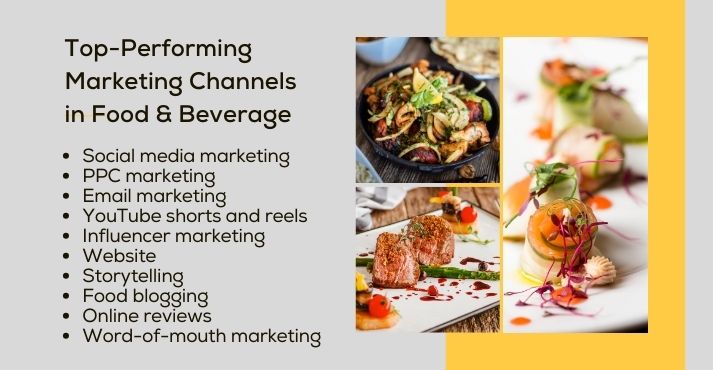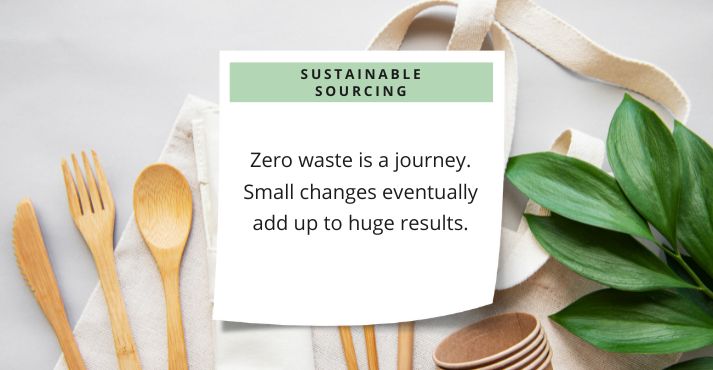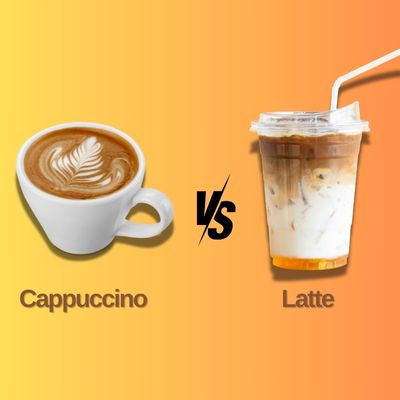Success isn’t only about serving good food.
In today’s super competitive world, the key lies in how well you market your food and beverage business to boost your brand visibility, drive traffic, and ultimately increase your sales.
With the global food market revenue projected to reach US$330.40bn by 2023, you need more than tempting eats and drinks to capture and retain consumers.
So, in food and beverage marketing, there is only one overarching goal: to get people to talk about your business.
What Is Food and Beverage Marketing?
Food and beverage marketing refers to establishing and maintaining a strong brand presence while fostering deep customer relationships and building brand loyalty.
F&B brands today aim to stay on top of the mind by retaining existing customers through consistent and meaningful interactions.
For example, when it comes to being an accomplice to the top-of-mind awareness among consumers, your brand must instantly come across their mind through audio or visual such as McDonald’s “I’m Lovin’ it’.
To achieve this, consider these food & beverage marketing tips:
- Delivering high-quality products consistently
- Creating and communicating unique value propositions
- Share the brand’s story to connect emotionally
- Engage through personalized and interactive campaigns
- Providing exceptional customer service
- Building trust through sustainability initiatives
No matter what type of marketing you consider, offline or online, you must build a visually appealing and consumer-centric strategy that entices buyers to purchase.
Importance of Food & Beverage Marketing
In a crowded market, hospitality marketing is the only thing that can set you apart. As a marketer in the F&B sector, you need to understand that effective marketing goes beyond product promotion.
It is all about making the consumers feel connected with the brand by being on the top of their minds and ensuring your brand is the first one that comes to their mind when they consider purchasing a particular food or beverage item.
This increase in recall will lead to repeat purchases and brand preferences, resulting in positive word-of-mouth and often becoming brand advocates. Brands leveraging word-of-mouth can quickly gain a competitive advantage and expand their customer base.
F&B marketing is a linchpin for brand success, delivering value and creating positive impressions that drive profitability.
The Benefits of Food and Beverage Marketing

Food and beverage marketing effectively bridges the gap between businesses and consumers by influencing food choices, promoting new products, and driving customer loyalty.
Increase Brand Awareness
Be visible and get recognized, as the F&B industry has a faster turnover. With thousands of food and beverage companies existing, marketing helps establish brand awareness across multiple channels to retain and attract new customers.
Maintain Stakeholder Relationships
Food and beverage marketing fosters more profound connections with key stakeholders in the hospitality industry, such as suppliers, distributors, and customers.
Marketing helps you convey a positive brand image and improve restaurant operations by maintaining a healthy relationship with stakeholders.
Gain Competitive Advantage
Food and beverage marketing allows you to have meaningful and close-up interactions with consumers about your brand ethos, unique value proposition, and product quality. It helps you develop a competitive advantage that brings in more customers.
Increase Sales and Revenue
The right message, delivered at the right time through the best marketing channel that reaches the customers on time, encourages them to spend more at your restaurant. It also helps you to ensure long-term financial stability for your business.
Top-Performing Marketing Channels in Food & Beverage

The first step in your marketing plan is identifying the top-performing channels. A passive approach doesn’t deliver results; instead, a proactive approach allows you to define content distribution that fits your audience.
Here are some of the top-performing marketing channels you can choose from:
- Social Media
- Email Marketing
- YouTube Vlogging And Tutorials
- Influencer Marketing
- Blogging
- Reputation Management
- Company Website
- SEO
- Customer Advocacy
Food & Beverage Brands Loves Social Media
According to Statista, 64.6% of the global population uses the Internet worldwide, of which 59.9% are also social media users.
Social media is a top marketing channel, from creating brand awareness to selling products. Social media utilizes data to effectively advertise and connect with target audiences and reach new audiences.
Need some tips for effective F&B social media marketing? Here you go:
- Share the social proof and user-generated content
- Repurpose your post and share it again
- Automate post publishing
- Respond to comments
- Interact with the customers
- Reach new Heights with Social Media Paid Advertising
As a food and beverage brand, you can reach new customers and retarget existing ones through paid social media advertisements.
Posting ads on social media is the best way to get in front of new audiences. Ensure you develop a clear brand voice and tone, maintain content consistency, and develop an emotional connection with the audience through paid ads.
Supercharge Your Campaigns for Success with Email Marketing
Despite the growth and prominence of different marketing channels, global e-mail users amount to 4.26 billion in 2023 and will grow to 4.73 billion in 2026.
Email marketing can help you supercharge your campaign in the following ways. For example,
- Welcome emails for new customers
- Food and beverage newsletter to educate audiences
- Follow-up emails to remind about products, dine-in experience, and experiences
- Share promotional content such as special events, discounts, and new launches.
- Ask for their reviews and get feedback.
To leverage the power of email marketing, make sure you are well aware of the purpose of the email, create compelling content, add visuals, use videos, and use effective calls to action.
YouTube Shorts and Reels are the Future
Monthly active users of YouTube shorts have reached two billion users worldwide. Short videos create excitement and capture the target audience’s attention.
YouTube short video content is another game-changer that has emerged with the power of mass marketing.
Food and beverage brands can use videos to educate customers and increase engagement. YouTube short videos and reels create content that encourages purchases, boosts retention, and creates brand loyalty.
Brand Credibility Using Influencer Marketing
From an influencer marketing perspective, food and beverage brands can come to life by stimulating the senses with short-form videos shared by influencers. They make the brand more relatable and approachable.
Influencer marketing makes the content go viral. Whether it is a live stream video or instagram marketing, food and beverage influencers, entice viewers to try it themselves.
Food and business brands can partner with celebrity food influencers to skyrocket their marketing. You can get a lot of visibility as their followers will come to know about your brand.
People Love Reading Food Blogs
Food and marketing brands can leverage the power of food blogging. By writing about upcoming product launches, new items on the menu, guest chefs, or recipes, blogs help you develop interest and excitement among the customer base.
Blogging channel offers several advantages for marketing, such as
- Increased brand visibility
- Authenticity and trust-building
- Product promotion
- Improved SEO
- Boosts website traffic
- Social media sharing
- Competitive advantage
Brand Review: The Ultimate Factor of Decision-Making
According to Statista, 35% of the global internet users aged 25 to 34 years use online reviews for brands and product research, and 52% of the users aged 25 to 34 years post reviews online.
It shows the power of brand reviews in ultimate decision-making for the consumers. By creating impactful content that delivers value and addresses the pain point of your customers, the F&B brand can reach new customers in the funnel.
Therefore, to become a top brand in the food and beverage industry, you must focus on reviews as a strategic marketing tool to yield positive ROI.
Website Adds to Brand Credibility
Your website is the center of your online presence. Websites help develop confidence among potential customers, differentiate your brand from competitors, serve as a hub for information, allow customers to access products, and foster a positive perception that can increase customer growth.
Here’s how a website can help F&B brands:
- It gives off an impression of professionalism
- Showcases positive reviews and testimonials
- Drives organic traffic from online platforms
- Facilitates direct engagement with customers
- Helps in gathering data through sign-up forms
- Keyword integration in website content improves SEO
- Content That Converts: Creating Irresistible Brand Stories
Content has the power to impact all forms of marketing channels. Creating value-driven content can attract, engage, and delight a specific target audience.
Here are some content marketing types you can create for your food and beverage brand.
- Recipe videos
- Cooking tips
- Ingredient spotlights
- Food fusion suggestions
- Behind-the-scenes
- Customer testimonials
- Holiday and seasonal discounts
- Infographics
- Food blog posts
- Interactive polls and quizzes
You can also use storytelling to wow your readers. Storytelling has a more significant impact on your target audience as it gives them a reason to engage with your brand. Also, storytelling forges an emotional connection and makes your F&B brand memorable in customers’ minds.
Customers As Brand Ambassadors – Positive Word of Mouth
When delighted by exceptional dining experiences or product quality, customers willingly share their enthusiasm with friends, family, and social media followers.
Turning customers into brand ambassadors offers many benefits in today’s competitive marketplace. Brands can leverage this by ensuring consistent quality, fostering strong customer relationships, and incentivizing referrals or user-generated content.
Also, brand ambassadors can increase brand loyalty, expand reach, work as social proof, and boost business sales.
With so many food and beverage marketing ideas to choose top-performing marketing channels, prioritize channels that’ll bring in the best return on investment.
Social Responsibility in Food and Beverage Marketing

Food and beverage marketing social responsibility entails promoting healthier choices, transparent labeling, and ethical practices. It aims to reduce the impact of marketing on unhealthy consumption patterns and to prioritize the well-being of consumers and the environment.
Today, consumers prefer brands that use sustainably sourced ingredients and maintain food chain transparency.
Ethical Marketing Practices
Here are some critical ethical marketing practices you adopt as a food and beverage brand.
- Transparency – Honest product descriptions and clear labeling of ingredients.
- Health and Nutrition Claims – Make accurate health and nutrition claims and avoid misleading consumers.
- Consumer Education – Educate consumers about ethical choices, such as purchasing products that support ethical labor practices or sustainable farming.
- Avoiding Greenwashing – Genuinely implementing ethical practices rather than merely using them as marketing tactics.
- Sustainable Packaging and Practices
Sustainable packaging and practices in the food and beverage industry involve using eco-friendly materials, minimizing waste, and adopting responsible sourcing and production methods to reduce environmental impact and support long-term sustainability goals.
How To Choose and Prioritize Marketing Channels For Your F&B Brand?
Now that we’ve covered the top-performing marketing channels, you must know how to choose and prioritize marketing channels for your F&B brand.
Leveraging your Data
With emerging restaurant technology and data analytics, F&B brands can evaluate campaign performance by gaining valuable insights through strategy optimization.
Target Audience
Identify where your audience spends their time and which platforms they engage with most frequently, ensuring your marketing efforts align with their preferences and behaviors.
Industry Benchmark and Competitor Analysis
Identifying areas where you may be underperforming to gain a competitive edge. Examine the industry benchmark and conduct an in-detailed competitor analysis. It will help you identify areas where you can deliver value and leverage the marketing channels.
Budget
Prioritize focused investments in one or two channels to yield positive ROI and allocate sufficient resources for meaningful insights and impactful results, avoiding diluting efforts across numerous platforms.
Future Trends in Food and Beverage Marketing
With rapid hospitality technology advancements, F&B marketing can be extremely tricky.
Here are some dynamic trends in the hospitality industry that will change how food and beverage brands market.
Expansion of social media channels
Social channels will be the new internet, as, by 2025, advertisers are expected to spend over 82 billion dollars on promoting their products on social networks. Food and beverage brands will move towards an immersive-interact model from the type-read-visual-reply model.
AI-Powered Personalized Marketing
There is more data in today’s marketing strategies of restaurants and hotels than ever. New research indicates that customers are more likely to engage with products or services where personalization is involved. It will not be limited to targeted offers but extends to the entire customer experience.
Voice-Optimized Search
Just like how marketers optimize marketing through SEO, they will do the same with voice search in the coming years as more people turn to devices like Alexa and Siri to do the searching.
Food and Beverage Marketing (FAQs)
What is food and beverage marketing?
Food and beverage marketing refers to promoting food and beverage =products through top-performing marketing channels. It can help food and beverage brands differentiate themselves from competitors.
How important is food and beverage marketing in the business?
Food and beverage marketing is an imperative part of the business as it increases brand awareness, influences consumer choices, and ultimately impacts sales and revenue.
How do you market a food and beverage business?
Here are the 10 best ways to market a food and beverage business:
- Social media marketing
- PPC marketing
- Email marketing
- YouTube shorts and reels
- Influencer marketing
- Website
- Storytelling
- Food blogging
- Online reviews
- Word-of-mouth marketing
Conclusion
Now that you have complete food and beverage marketing ideas, you can choose the best techniques for your business. Marketers must be agile and flexible to reach customers on the right marketing channel.
From creating personalized email campaigns to exceptional social media presence and writing food blog posts to celebrity endorsements, opt for marketing tactics that bring results.
In a nutshell, keep the above food and beverage marketing strategies in mind to stay ahead of the competition and thrive above the industry benchmark, no matter what the future holds.








